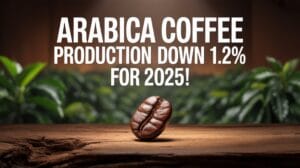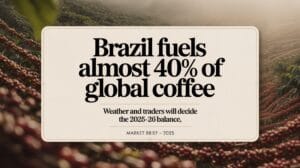Brazil’s coffee story for 2025 centers on robusta beans. CONAB says the country will harvest 55.7 million sixty-kilogram bags, a 2.7 percent rise from last year. Most of that jump comes from conilon robusta, which is set to climb 28 percent to 18.7 million bags. Arabica will slip 6.6 percent to about 37 million bags because dry spells hit the trees during their low biennial cycle. The mix means Brazil can still push export trends higher, even while arabica coffee quality worries buyers.
Espírito Santo leads robusta zones with 13.1 million bags. Bahia has moved back into next place at an estimated 2.5 million bags thanks to new irrigation lines. Rondônia follows close behind with 2.28 million bags. export earnings for the quarter already reached $4.1 billion, a 68.9% year-on-year lift. In Minas Gerais, recent above-average rains helped arabica orchards, but they won’t erase the cycle’s drop. Machines and drip systems are filling labor gaps across all regions and keeping yields steady despite tricky weather.
Global buyers are watching closely. USDA projects Brazil will ship 46.65 million bags in the 2024/25 marketing year, up 2.4 percent from the previous year. Short crops in other nations are fueling this demand.
Still, limited high-grade arabica could tighten supply and nudge prices upward. At the same time, rising stockpiles tracked by ICE are weighing on the market. New U.S. tariffs of 10 percent on Brazilian beans may cool some orders, but traders expect general export trends to stay strong.
Back on the farms, reservoirs in Espírito Santo and Bahia are fuller than last year, letting farmers water robusta trees during dry weeks. This extra care has lifted bean size and color scores, pushing coffee quality ratings higher for conilon.
Meanwhile, arabica from Cerrado Mineiro is already 81 percent picked, and early cupping tests show mild flavor despite the drought. Analysts say the record robusta crop, combined with careful sorting of arabica lots, keeps Brazil on track for another boom year, even when one variety stumbles.





